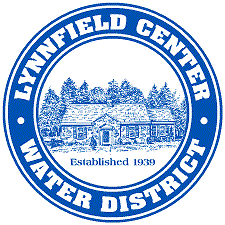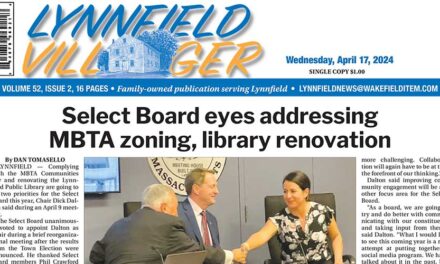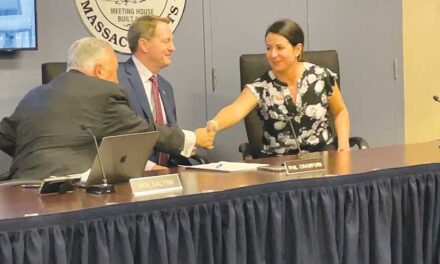Published March 24, 2021

By DAN TOMASELLO
LYNNFIELD — Ratepayers in the Lynnfield Center Water District will be asked to approve a $9.8 million capital improvement project during the Annual District Meeting on Monday, May 10.
LCWD officials and CDM Smith representatives gave an overview of the three projects during an informational meeting held on Zoom teleconference last week. The projects involve upgrading the LCWD’s existing infrastructure as well as getting supplemental water from the Massachusetts Water Resource Authority (MWRA) via Wakefield.
“This is the beginning of what we hope is a successful launch of a capital program that will create some sustainability in the system and set the LCWD’s infrastructure up to succeed for its customers in the years to come,” said Superintendent John Scenna. “We have looked at our existing infrastructure, and it is clear we cannot stay the course.”
CDM Smith project engineer Mike Nelson gave an overview of the different projects. CDM Smith project Anne Malenfant discussed a variety of technical aspects associated with treating the two different water sources.
Scenna said the three projects would result in an average water bill increase of $200.
“That is not an immediate increase,” said Scenna. “These increases should occur over multiple years to smooth out the increase on customers and avoid rate shock. The rates have been set for this fiscal year.”
If ratepayers approve the projects, Nelson said they would be completed by 2023.
Supplemental water
In order to address the LCWD’s supplemental water issues, Nelson said the LCWD is looking to partner with Wakefield in order to get water from the MWRA.
Nelson said the cost to connect with Wakefield totals $1.6 million. Additionally, he said the cost to join the MWRA includes a $1.5 million entry fee plus $400,000 for permitting.
The supplemental water project involves connecting the Wakefield and LCWD systems at the Main Street and Bay State Road intersection. Nelson said having the LCWD partner with Wakefield would add up to 250 gallons per minute of MWRA water into the district’s system, which he said would improve water pressure.
“It makes sense from an engineering standpoint because the water will be able to flow without having to pump it,” said Nelson.
Scenna said getting additional water from Wakefield would supplement the district’s existing supply by 25 percent.
Nelson said LCWD officials and CDM Smith engineers examined alternatives such as building more wells and getting supplemental from other communities such as Andover, Peabody and the Lynnfield Water District. He said the Wakefield proposal is the most cost-effective option.
“It makes sense from an economic standpoint because it would be the least impactful to the overall rates,” said Nelson.
Scenna said the cost to get all of the LCWD’s water from the MWRA would exceed $20 million.
“The overall cost was two to two-and-a-half times the cost we are currently talking about,” said Scenna.
Nelson said the Wakefield pact will allow the LCWD to “diversify its water sources.”
“We have groundwater from two basins,” said Nelson. “The Ipswich River basin is a highly regulated and stressed basin. The North Coastal basin is not as stressed, but still requires permitted withdrawals. Bringing in surface water will alleviate the burden on the existing systems because the district would be pulling water from three different sources and will not be overly relying any one of them.”
Scenna said the inter-municipal agreement with Wakefield will tentatively cost between $865,000 and $915,000. He said the pact is still being negotiated.
“It includes construction, engineering, project management and contingency costs,” said Scenna.
Scenna said the inter-municipal pact with Wakefield will also include a “wheeling rate.”
“MWRA’s water will come into the district through Wakefield’s system,” said Scenna. “There are costs associated with using that system. We have crafted an agreement that is similar to agreements Wakefield has with Melrose and Stoneham. We would take the wholesale rate of water from the MWRA, and Wakefield will be marking it up 20 percent. That wheeling rate would go to Wakefield and we would pay the MWRA directly. We still have a little more work to do.”
Nelson recalled that Wakefield and Woburn blend MWRA water with additional water sources in those communities.
While Nelson said getting supplemental water from Wakefield would diversify the district’s water sources, he said there will still be outdoor restrictions because of rules established by the Water Management Act.
“The Water Management Act permits water withdrawals in Massachusetts,” said Nelson. “The goal of this program is to get back to the minimum amount of water restrictions possible to comply with the permits that are in place right now.”
Greensand filter treatment plant
In order to address the discolored water issues impacting residents living near the North Reading line, Nelson said CDM Smith is recommending that the LCWD build a greensand filter treatment plant at the Glen Drive station. The project’s price tag totals $6.3 million.
Nelson said the new plant will be used to treat iron and manganese, which LCWD officials said are the culprits of the water quality issues. He recalled that a greensand filter treatment plant was built at the Phillips Road station in the 1990s.
“The Apple Hill neighborhood is taking the brunt of the iron and manganese that is coming out of the ground,” said Nelson. “That is a huge quality of life issue. We have a problem there.”
Nelson said the greensand filter plant will need to comply with regulations established by the Massachusetts Department of Environmental Protection.
“It will be designed to handle future water quality concerns and will produce consistently clean, great tasting drinking water,” said Nelson.
Nelson said the new plant will enable the LCWD to treat water at its Main Street station as well.
“That will ensure 100 percent of the district’s water is treated,” said Nelson.
Nelson said CDM Smith will be monitoring to see if any per- and polyfluoroalkyl substances (PFAS) are detected in the Glen Drive station. According to the Environmental Protection Agency, PFAS are a group of man-made chemicals that have been manufactured and used in a variety of industries around the world since the 1940s. PFAS have been attributed to causing harmful health effects.
“Testing for PFAS will be part of this program,” said Nelson. “There are no indications it is going to be a problem for Lynnfield Center Water District, but that is going to be vetted out as part of this process.”
Nelson also said the Ipswich River will not run out of water.
“The LCWD’s source aquifers will not run out of water because they are hundreds of feet deep in the rock,” said Nelson. “They will not be running out of water now and in the future. There is no scientific link between municipal water withdrawals from deep aquifers and base flow in the river. Municipal groundwater withdrawals have fallen to early 1960 levels. Studies have shown stormwater infiltration, land use and climate change are way more impactful than municipal water withdrawals from the aquifers.”
Station 1
Nelson also noted that the capital improvement project entails bringing Station 1 back into service this summer, which would be funded through the LCWD’s operating budget.
Station 1, which was the first LCWD station built in 1937, was put back into service last summer after the LCWD declared a water emergency with the Massachusetts Department of Environmental Protection due to high water usage that was made worse by drought conditions.
“We would get an additional 50 gallons per minute out of Station 1,” said Nelson.
Reaction
After Scenna, Nelson and CDM Smith civil engineer Anne Malenfant gave an overview of the three projects, they answered questions from ratepayers.
Maiden Lane resident Leon Glicksman asked if LCWD officials considered getting more water from Wakefield and not pursuing plans to build the Glen Drive treatment plant.
Water Commissioner Andy Youngren said building the treatment plant will be more affordable to ratepayers over the long haul.
“The treatment plant has a high fixed cost, but a very low variable cost,” said Youngren. “Over the long-term, you are going to pay more for MWRA water than water from the district.”
Scenna agreed.
“The combination of a treatment plant plus the interconnection gives us the opportunity to bring more water in,” said Scenna.
Patrice Lane resident Pat Campbell asked if the LCWD will be able to shut off the MWRA water.
While Scenna said there will be a valve that will be able to shut off the MWRA water, he said the LCWD is planning on running both water sources “at all times.”
“We will just regulate what we take,” said Scenna.
Select Board member Phil Crawford inquired if the projects would improve water pressure in the district, particularly in the King James Grant area.
Water Commissioners Chairman Joe Maney said increasing water quantity will improve water pressure.
“If there is more water in the tanks, the pressure will improve,” said Maney.
Water Commissioner Jack Adelson expressed his support for the project.
“It meets all of the needs that we have,” said Adelson.
After the discussion concluded, the water commissioners voted to include the $9.8 million project on a warrant article for the Annual District Meeting.
Maney urged residents to closely follow the project.
“We can recommend it, but the ratepayers are the ones who are going to approve it or not,” said Maney.




